#Cloud Memorystore for Redis
Explore tagged Tumblr posts
Text
Valkey 7.2 On Memorystore: Open-Source Key-Value Service
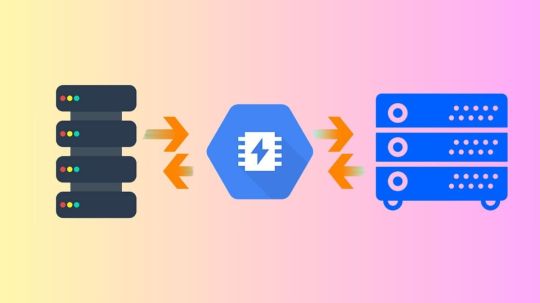
The 100% open-source key-value service Memorystore for Valkey is launched by Google Cloud.
In order to give users a high-performance, genuinely open-source key-value service, the Memorystore team is happy to announce the preview launch of Valkey 7.2 support for Memorystore.
Memorystore for Valkey
A completely managed Valkey Cluster service for Google Cloud is called Memorystore for Valkey. By utilizing the highly scalable, reliable, and secure Valkey service, Google Cloud applications may achieve exceptional performance without having to worry about handling intricate Valkey deployments.
In order to guarantee high availability, Memorystore for Valkey distributes (or “shards”) your data among the primary nodes and duplicates it among the optional replica nodes. Because Valkey performance is greater on many smaller nodes rather than fewer bigger nodes, the horizontally scalable architecture outperforms the vertically scalable architecture in terms of performance.
Memorystore for Valkey is a game-changer for enterprises looking for high-performance data management solutions reliant on 100% open source software. It was added to the Memorystore portfolio in response to customer demand, along with Memorystore for Redis Cluster and Memorystore for Redis. From the console or gcloud, users can now quickly and simply construct a fully-managed Valkey Cluster, which they can then scale up or down to suit the demands of their workloads.
Thanks to its outstanding performance, scalability, and flexibility, Valkey has quickly gained popularity as an open-source key-value datastore. Valkey 7.2 provides Google Cloud users with a genuinely open source solution via the Linux Foundation. It is fully compatible with Redis 7.2 and the most widely used Redis clients, including Jedis, redis-py, node-redis, and go-redis.
Valkey is already being used by customers to replace their key-value software, and it is being used for common use cases such as caching, session management, real-time analytics, and many more.
Customers may enjoy a nearly comparable (and code-compatible) Valkey Cluster experience with Memorystore for Valkey, which launches with all the GA capabilities of Memorystore for Redis Cluster. Similar to Memorystore for Redis Cluster, Memorystore for Valkey provides RDB and AOF persistence, zero-downtime scaling in and out, single- or multi-zone clusters, instantaneous integrations with Google Cloud, extremely low and dependable performance, and much more. Instances up to 14.5 TB are also available.
Memorystore for Valkey, Memorystore for Redis Cluster, and Memorystore for Redis have an exciting roadmap of features and capabilities.
The momentum of Valkey
Just days after Redis Inc. withdrew the Redis open-source license, the open-source community launched Valkey in collaboration with the Linux Foundation in March 2024 (1, 2, 3). Since then, they have had the pleasure of working with developers and businesses worldwide to propel Valkey into the forefront of key-value data stores and establish it as a premier open source software (OSS) project. Google Cloud is excited to participate in this community launch with partners and industry experts like Snap, Ericsson, AWS, Verizon, Alibaba Cloud, Aiven, Chainguard, Heroku, Huawei, Oracle, Percona, Ampere, AlmaLinux OS Foundation, DigitalOcean, Broadcom, Memurai, Instaclustr from NetApp, and numerous others. They fervently support open source software.
The Valkey community has grown into a thriving group committed to developing Valkey the greatest open source key-value service available thanks to the support of thousands of enthusiastic developers and the former core OSS Redis maintainers who were not hired by Redis Inc.
With more than 100 million unique active users each month, Mercado Libre is the biggest finance, logistics, and e-commerce company in Latin America. Diego Delgado discusses Valkey with Mercado Libre as a Software Senior Expert:
At Mercado Libre, Google Cloud need to handle billions of requests per minute with minimal latency, which makes caching solutions essential. Google Cloud especially thrilled about the cutting-edge possibilities that Valkey offers. They have excited to investigate its fresh features and add to this open-source endeavor.”
The finest is still to come
By releasing Memorystore for Valkey 7.2, Memorystore offers more than only Redis Cluster, Redis, and Memcached. And Google Cloud is even more eager about Valkey 8.0’s revolutionary features. Major improvements in five important areas performance, reliability, replication, observability, and efficiency were introduced by the community in the first release candidate of Valkey 8.0. With a single click or command, users will be able to accept Valkey 7.2 and later upgrade to Valkey 8.0. Additionally, Valkey 8.0 is compatible with Redis 7.2, exactly like Valkey 7.2 was, guaranteeing a seamless transition for users.
The performance improvements in Valkey 8.0 are possibly the most intriguing ones. Asynchronous I/O threading allows commands to be processed in parallel, which can lead to multi-core nodes working at a rate that is more than twice as fast as Redis 7.2. From a reliability perspective, a number of improvements provided by Google, such as replicating slot migration states, guaranteeing automatic failover for empty shards, and ensuring slot state recovery is handled, significantly increase the dependability of Cluster scaling operations. The anticipation for Valkey 8.0 is already fueling the demand for Valkey 7.2 on Memorystore, with a plethora of further advancements across several dimensions (release notes).
Similar to how Redis previously expanded capability through modules with restricted licensing, the community is also speeding up the development of Valkey’s capabilities through open-source additions that complement and extend Valkey’s functionality. The capabilities covered by recently published RFCs (“Request for Comments”) include vector search for extremely high performance vector similarly search, JSON for native JSON support, and BloomFilters for high performance and space-efficient probabilistic filters.
Former vice president of Gartner and principal analyst of SanjMo Sanjeev Mohan offers his viewpoint:
The advancement of community-led initiatives to offer feature-rich, open-source database substitutes depends on Valkey. Another illustration of Google’s commitment to offering really open and accessible solutions for customers is the introduction of Valkey support in Memorystore. In addition to helping developers looking for flexibility, their contributions to Valkey also support the larger open-source ecosystem.
It seems obvious that Valkey is going to be a game-changer in the high-performance data management area with all of the innovation in Valkey 8.0, as well as the open-source improvements like vector search and JSON, and for client libraries.
Valkey is the secret to an OSS future
Take a look at Memorystore for Valkey right now, and use the UI console or a straightforward gcloud command to establish your first cluster. Benefit from OSS Redis compatibility to simply port over your apps and scale in or out without any downtime.
Read more on govindhtech.com
#Valkey72#Memorystore#OpenSourceKey#stillcome#GoogleCloud#MemorystoreforRedisCluster#opensource#Valkey80#vectorsearch#OSSfuture#momentum#technology#technews#news#govindhtech
2 notes
·
View notes
Text
Google Cloud、Redisをフォークした「Valkey 7.2」のマネージドサービス「Memorystore for Valkey」プレビュー版を開始
Google Cloudは、Redisをフォークしたインメモリデータベース「Valkey」をマネージドサービスで提供する「Memorystore for Valkey」プレビュー版の提供開始を発表しました。 Google Cloudは以前か... https://www.publickey1.jp/blog/24/google_cloudredisvalkey_72memorystore_for_valkey.html?utm_source=dlvr.it&utm_medium=tumblr Publickey
0 notes
Text
Cloud Memorystore for Redis
After we made a basic comparison of AWS vs Google Cloud for DevOps, we encountered a new interesting tool from Google introduced this May. It is called Google Cloud Memorystore and is fully managed Redis instances by Google. In other words, it is Cloud Memorystore for Redis. Let’s explore w...
#application caches#applications#browser#cache#Cloud Memorystore#Cloud Memorystore for Redis#Cloud storage#cloud storage for Redis#data#DevOps#GCP#google#Google Cloud#Google Grade Security#Google Platform for DevOps#IAM role-based access control#in-memory data store service#in-memory data structure store#Memorystore#message broker#Redis#Redis protocol#Redis protocol compatible#scaling#software development#used as a database
0 notes
Photo

Google Cloud launches a managed Memcached service Google today announced the beta of Memorystore for Memcached, a new service that provides a fully managed in-memory datastore that is compatible with the open-source Memcached protocol. It will join Redis in the Memorystore family, which first launched in 201… Read More
0 notes
Text
Google Cloud launches a managed Memcached service
Google today announced the beta of Memorystore for Memcached, a new service that provides a fully managed in-memory datastore that is compatible with the open-source Memcached protocol. It will join Redis in the Memorystore family, which first launched in 2018.
As Gopal Ashok, Google’s product manager for Memorystore notes in today’s announcement, Redis remains a popular choice for use cases like session stores, gaming leaderboard, stream analytics, threat detection and API rate limiting, while Memcached is typically used as a caching layer for databases. Developers also regularly use Memcached as a session store and with this new service, developers can scale their clusters up to 5TB of memory per instance.
Since the service is fully compatible with Memcached, developers should be able to take any of their applications that use the protocol and migrate them over to Google Cloud and its Memorystore platform. As a fully managed service, Google will handle all of the routine tasks like monitoring and patching. Figuring out the right size of a cache remains a bit of an art, though, but Google Cloud argues that its detailed metrics will allow developers to easily scale their instances up and down as needed to optimize the service for their specific use cases. Those metrics, the company notes, are exposed in Cloud Monitoring, Google Cloud’s centralized monitoring dashboard, and the Cloud Console.
Currently, Memorystore for Memcached can be used for applications that run on Compute Engine, Google Kubernetes Engine (GKE), App Engine Flex, App Engine Standard and Cloud Functions.
It’s worth noting that Amazon, with ElastiCache for Memcached, and specialized startups like MemCachier. And Redis Labs, too, is offering a fully managed Memcached service that can run on AWS, Azure and Google Cloud.
0 notes
Text
Google Cloud launches a managed Memcached service

Google today announced the beta of Memorystore for Memcached, a new service that provides a fully managed in-memory datastore that is compatible with the open-source Memcached protocol. It will join Redis in the Memorystore family, which first launched in 2018.
As Gopal Ashok, Google’s product manager for Memorystore notes in today’s announcement, Redis remains a popular choice for use cases…
View On WordPress
0 notes
Text
Best of Google Database
New Post has been published on https://is.gd/42EFDP
Best of Google Database

Google Cloud Database By
Google provides 2 different types of databases i.e google database
Relational
No-SQL/ Non-relational
Google Relational Database
In this google have 2 different products .
Cloud SQL
Cloud Spanner
Common uses of this relational database are like below
Compatibility
Transactions
Complex queries
Joins
Google No-SQL/ Non-relational Database
In this google provide 4 different types of product or databases
Cloud BigTable
Cloud Firestore
Firebase Realtime database
Cloud Memorystore
Common uses cases for this is like below
TimeSeries data
Streaming
Mobile
IoT
Offline sync
Caching
Low latency
Google relational Databases
Cloud SQL
It is Google fully managed service that makes easy to setup MySQL, PostgreSQL and SQL server databases in the cloud.
Cloud SQL is a fully-managed database service that makes easy to maintain, Manage and administer database servers on the cloud.
The Cloud SQL offers high performance, high availability, scalability, and convenience.
This Cloud SQL takes care of managing database tasks that means you only need to focus on developing an application.
Google manage your database so we can focus on our development task. Cloud SQL is perfect for a wide variety of applications like geo-hospital applications, CRM tasks, an eCommerce application, and WordPress sites also.
Features of Cloud SQL
Focus on our application: managing database is taken care of by google so we can focus on only application development.
Simple and fully managed: it is easy to use and it automates all backups, replication, and patches and updates are having 99.955 of availability anywhere in the world. The main feature of Cloud SQL is automatic fail-over provides isolation from many types of infrastructure hardware and software. It automatically increases our storage capacity if our database grows.
Performance and scalability: it provides high performance and scalability up to 30 TB of storage capacity and 60,000 IOPS and 416Gb of ram per instance. Having 0 downtimes.
Reliability and Security: As it is google so security issue is automatically resolved but the data is automatically encrypted and Cloud SQL is SSAE 16, ISO 27001 and PCI DSS v3.0 compliant and supports HIPAA compliance so you can store patient data also in Cloud SQL.
Cloud SQL Pricing:
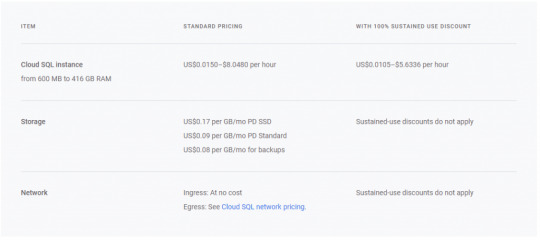
Google Cloud SQL Pricing -Image From Official Google Site
Cloud Spanner
It is a fully managed scalable relational database service for regional and global application data.
Cloud spanner is the first database who takes advantage of relational database and non-relational database.
It is enterprise-grade, globally distributed and strongly consistent database service which built for cloud and it combines benefits of relational and non-relational horizontal scale.
By using this combination you can deliver high-performance transactions and strong consistency across rows, regions and continent.
Cloud spanner have high availability of 99.999% it has no planned downtime and enterprise-grade security.

Google Cloud Spanner Features:- Image from official google site
Features of Cloud Spanner:
Scale+SQL:– in today’s world most database fail to deliver consistency and scale but at their, Cloud Spanner comes what it means? It means Cloud Spanner provides you advantage of relational database structure and not relational database scale and performance feature with external consistency across rows, regions and continents.
Cloud spanner scales it horizontally and serves data with low latency and along with that it maintains transactional consistency and industry-leading availability means 99.999%. It can scale up arbitrarily large database size means what It provides it avoids rewrites and migrations.
Less Task– it means google manage your database maintenance instead of you. If you want to replicate your database in a few clicks only you can do this.
Launch faster: it Is relational database with full relational semantics and handles schema changes it has no downtime. This database is fully tested by google itself for its mission-critical applications.
Security and Control:- encryption is by-default and audit logging, custom manufactured hardware and google owned and controlled global network.
Multi-language support means support c#, Go, Java, Php, Python and Ruby.
Pricing for Cloud Spanner:

Google Cloud Spanner Pricing – Image from official google site
Non-relational Database by Google
BigTable
This Bigtable database is created by Google, it is compressed, high performance and proprietary data storage system which is created by Google and is built on top of google file system, LevelDB and other few google technologies.
This database development is starting in 2004 and now it is widely used by google like web indexing,google maps, google book search and google earth, blogger, google code, youtube.
The google is designed its own database because they need high scalability and better control over performance.
Bigtable is like wide column store. It maps 2 arbitrary string values which are row key and column key and timestamp for 3-dimensional mappings into an arbitrary byte array.
Remember it is not a relational database and it is more kind of sparse, distributed multi-dimensional sorted map.
BigTable is designed to scale in petabyte range across hundreds and thousands of machines and also to add additional commodity hardware machines is very easy in this and there is no need for reconfiguration.
Ex.
Suppose google copy of web can be stored in BigTable where row key is what is domain URL and Bigtable columns describe various properties of a web page and every column holds different versions of webpage.
He columns can have different timestamped versions of describing different copies of web page and it stores timestamp page when google retrieves that page or fetch that page.
Every cell in Bigtable has zero or timestamped versions of data.
In short, Bigtable is like a map-reduce worker pool.
A google cloud Bigtable is a petabyte-scale, fully managed and it is NoSQL database service provided by Google and it is mainly for large analytical and operational workloads.
Features Of Google Cloud BigTable:
It is having low latency and massively scalable NoSQL. It is mainly ideal for ad tech, fin-tech, and IoT. By using replication it provides high availability, higher durability, and resilience in the face of zonal failures. It is designed for storage for machine learning applications.
Fast and Performant
Seamless scaling and replication
Simple and integrated- it means it integrates easily with popular big data tools like Hadoop, cloud dataflow and Cloud Dataproc also support HBase API.
Fully Managed- means google manage the database and configuration related task and developer needs only focus on development.
Charges for BigTable- server: us-central
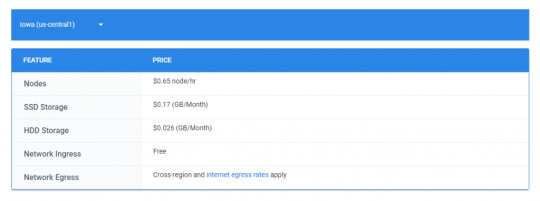
Google Bigtable Pricing- Image from official google site
Cloud Firestore
It is mainly serverless. Cloud Firestore is fast and serverless and fully managed and cloud-native NoSQL. It is document database which simplifies our storing data, syncing data and querying data from your IoT devices, mobile devices or web at global scale. It also provides offline support and its security features and integration with firebase and googles cloud platform.
Cloud Firestore features are below:
You can increase your development velocity with serverless: Is a cloud-native database and Cloud Firestore provides automatic scaling solution and it takes that advantage from googles powerful infrastructure. It provides live synchronization and offline support and also supports ACID properties for hundreds of documents and collections. From your mobile you can directly talk with cloud Firestore.
Synchronization of data on different devices: Suppose client use the different platform of your app means mobile, tab, desktop and when it do changes one device it will automatically reflected other devices with refresh or firing explicit query from user. Also if your user does offline changes and after while he comes back these changes sync when he is online and reflected across.
Simple and effortless: Is robust client libraries. By using this you can easily update and receive new data. You can scale easily as your app grows.
Enterprise-grade and scalable NoSQL: It is fast and managed NoSQL cloud database. It scales by using google infrastructure with horizontal scaling. It has built-in security access controls for data and simple data validations.
Pricing of Google Cloud Firestore:
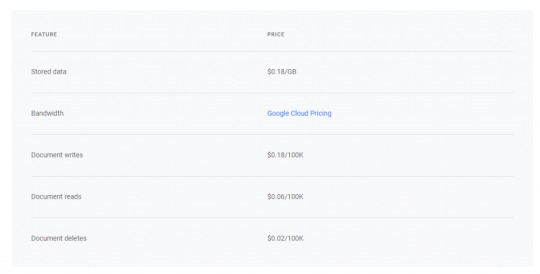
Google Cloud Firestore Pricing – Image from official googles site
FireBase
By tag line, it stores and sync data real-time. It stores data in JSON format. Different devices can access the same database.
It is also optimized for offline use and is having strong user-based security. This is also cloud-hosted database with a NoSQL database. It syncs In real-time across all clients and remains available if you go offline.
Capabilities of FireBase:
Realtime
Offline
Accessible from client devices
Scales across multiple databases: Means if you have blaze plan and your app go grow very fast and you need to scale your database so you can do in same firebase project with multiple database instances.
Firebase allows you to access the database from client-side code directly. Data is persisted locally and offline also in this realtime events are continuous fires by using this end-user experiences realtime responsiveness. When the client disconnected data is stored locally and when he comes online then it syncs with local data changes and merges automatically conflicts.
Firebase designed only to allow operations that can execute quickly.
Pricing of Firebase
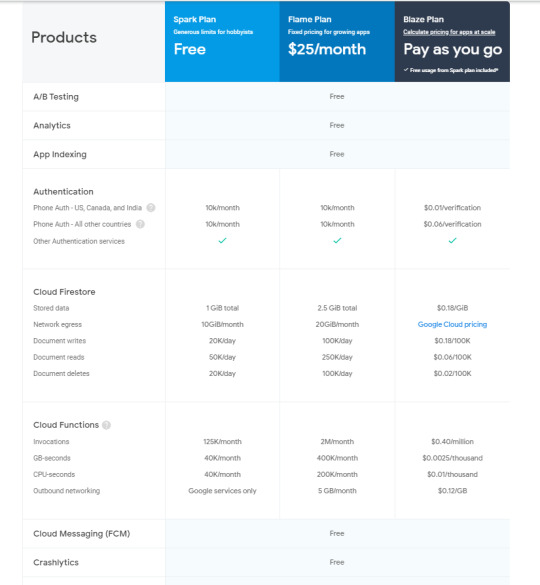
Google Firebase pricing-image from official google site
Cloud MemoryStores
This is an in-memory data store service for Redis. It is fully managed in-memory data store service which is built for scalability, security and highly available infrastructure which is managed by Google.
It is very much compatible with Redis protocol so it allows easy migration with zero code changes. When you want to store your app data in sub-millisecond then you can use this.
Features of Cloud memory stores:
It has the power of open-source Redis database and googles provide high availability, failure and monitoring is done by google
Scale as per your need:- by using this sub-millisecond latency and throughput achieve. It supports instances up to 300 Gb and network throughput 12 Gbps.
It is highly available- 99.9% availability
Google grade security
This is fully compatible with Redis protocol so your open-source Redis move to cloud memory store without any code change by using simple import and export feature.
Price for Cloud MemoryStore:

Google Cloud Memorystore price – image from official site of google
0 notes
Text
AWS/Azure/GCPサービス比較 2019.05
from https://qiita.com/hayao_k/items/906ac1fba9e239e08ae8?utm_campaign=popular_items&utm_medium=feed&utm_source=popular_items

はじめに
こちら のAWSサービス一覧をもとに各クラウドで対応するサービスを記載しています
AWSでは提供されていないが、Azure/GCPでは提供されているサービスが漏れている場合があります
主観が含まれたり、サービス内容が厳密に一致していない場合もあると思いますが、ご容赦ください
Office 365やG SuiteなどMicrsoft/Googleとして提供されているものは括弧書き( )で記載しています
物理的なデバイスやSDKなどのツール群は記載していません
Analytics
AWS Azure GCP
データレイクへのクエリ Amazon Athena Azure Data Lake Analytics Google BigQuery
検索 Amazon CloudSearch Azure Search -
Hadoopクラスターの展開 Amazon EMR HD Insight/Azure Databricks CloudDataproc
Elasticsearchクラスターの展開 Amazon Elasticserach Service - -
ストリーミング処理 Amazon Kinesis Azure Event Hubs Cloud Dataflow
Kafkaクラスターの展開 Amazon Managed Streaming for Kafka - -
DWH Amazon Redshift Azure SQL Data Warehouse Google BigQuery
BIサービス Quick Sight (Power BI) (Goolge データーポータル)
ワークフローオーケストレーション AWS Data Pipeline Azure Data Factory Cloud Composer
ETL AWS Glue Azure Data Factory Cloud Data Fusion
データレイクの構築 AWS Lake Formation - -
データカタログ AWS Glue Azure Data Catalog Cloud Data Catalog
Application Integration
AWS Azure GCP
分散アプリケーションの作成 AWS Step Functions Azure Logic Apps -
メッセージキュー Amazon Simple Queue Service Azure Queue Storage -
Pub/Sub Amazon Simple Notification Service Azure Service Bus Cloud Pub/Sub
ActiveMQの展開 Amazon MQ
GraphQL AWS AppSync - -
イベントの配信 Amazon CloudWatch Events Event Grid -
Blockchain
AWS Azure GCP
ネットワークの作成と管理 Amazon Managed Blockchain Azure Blockchain Service -
台帳データベース Amazon Quantum Ledger Database - -
アプリケーションの作成 - Azure Blockchain Workbench -
Business Applications
AWS Azure GCP
Alexa Alexa for Business - -
オンラインミーティング Amazon Chime (Office 365) (G Suite)
Eメール Amazon WorkMail (Office 365) (G Suite)
Compute
AWS Azure GCP
仮想マシン Amazon EC2 Azure Virtual Machines Compute Engine
オートスケール Amazon EC2 Auto Scaling Virtual Machine Scale Sets Autoscaling
コンテナオーケストレーター Amazon Elastic Container Service Service Fabric -
Kubernetes Amazon Elastic Container Service for Kubernetes Azure Kubernetes Service Google Kubernetes Engine
コンテナレジストリ Amazon Elastic Container Registry Azure Container Registry Container Registry
VPS Amazon Lightsail - -
バッチコンピューティング AWS Batch Azure Batch -
Webアプリケーションの実行環境 Amazon Elastic Beanstalk Azure App Service App Engine
Function as a Service AWS Lambda Azure Functions Cloud Functions
サーバーレスアプリケーションのリポジトリ AWS Serverless Application Repository - -
VMware環境の展開 VMware Cloud on AWS Azure VMware Solutions -
オンプレミスでの展開 AWS Outposts Azure Stack Cloud Platform Service
バイブリットクラウドの構築 - - Anthos
ステートレスなHTTPコンテナの実行 - - Cloud Run
Cost Management
AWS Azure GCP
使用状況の可視化 AWS Cost Explorer Azure Cost Management -
予算の管理 AWS Budgets Azure Cost Management -
リザーブドインスタンスの管理 Reserved Instance Reporting Azure Cost Management -
使用状況のレポート AWS Cost & Usage Report Azure Cost Management -
Customer Engagement
AWS Azure GCP
コンタクトセンター Amazon Connect - Contact Center AI
エンゲージメントのパーソナライズ Amazon Pinpoint Notification Hubs -
Eメールの送受信 Amazon Simple Email Service - -
Database
AWS Azure GCP
MySQL Amazon RDS for MySQL/Amazon Aurora Azure Database for MySQL Cloud SQL for MySQL
PostgreSQL Amazon RDS for PostgreSQL/Amazon Aurora Azure Database for PostgreSQL Cloud SQL for PostgreSQL
Oracle Amazon RDS for Oracle - -
SQL Server Amazon RDS for SQL Server SQL Database Cloud SQL for SQL Server
MariaDB Amazon RDS for MySQL for MariaDB Azure Database for MariaDB -
NoSQL Amazon DynamoDB Azure Cosmos DB Cloud Datastore/Cloud Bigtable
インメモリキャッシュ Amazon ElastiCache Azure Cache for Redis Cloud Memorystore
グラフDB Amazon Neptune Azure Cosmos DB(API for Gremlin) -
時系列DB Amazon Timestream - -
MongoDB Amazon DocumentDB (with MongoDB compatibility) Azure Cosmos DB(API for MongoDB) -
グローバル分散RDB - - Cloud Spanner
リアルタイムDB - - Cloud Firestore
エッジに配置可能なDB - Azure SQL Database Edge -
Developer Tools
AWS Azure GCP
開発プロジェクトの管理 AWS CodeStar Azure DevOps -
Gitリポジトリ AWS CodeCommit Azure Repos Cloud Source Repositories
継続的なビルドとテスト AWS CodeBuild Azure Pipelines Cloud Build
継続的なデプロイ AWS CodeDeploy Azure Pipelines Cloud Build
パイプライン AWS CodePipeline Azure Pipelines Cloud Build
作業の管理 - Azure Boards -
パッケージレジストリ - Azure Artifacts -
テスト計画の管理 - Azure Test Plans -
IDE AWS Cloud9 (Visual Studio Online) -
分散トレーシング AWS X-Ray Azure Application Insights Stackdriver Trace
End User Computing
AWS Azure GCP
デスクトップ Amazon WorkSpaces Windows Virtual Desktop -
アプリケーション���トリーミング Amazon AppStream 2.0 - -
ストレージ Amazon WorkDocs (Office 365) (G Suite)
社内アプリケーションへのアクセス Amazon WorkLink Azure AD Application Proxy -
Internet of Things
AWS Azure GCP
デバイスとクラウドの接続 AWS IoT Core Azure IoT Hub Cloud IoT Core
エッジへの展開 AWS Greengrass Azure IoT Edge Cloud IoT Edge
デバイスから任意の関数を実行 AWS IoT 1-Click - -
デバイスの分析 AWS IoT Analytics Azure Stream Analytics/Azure Time Series Insights -
デバイスのセキュリティ管理 AWS IoT Device Defender - -
デバイスの管理 AWS IoT Device Management Azure IoT Hub Cloud IoT Core
デバイスで発生するイベントの検出 AWS IoT Events - -
産業機器からデータを収集 AWS IoT SiteWise - -
IoTアプリケーションの構築 AWS IoT Things Graph Azure IoT Central -
位置情報 - Azure Maps Google Maps Platform
実世界のモデル化 - Azure Digital Twins
Machine Learning
AWS Azure GCP
機械学習モデルの構築 Amazon SageMaker Azure Machine Learning Service Cloud ML Engine
自然言語処理 Amazon Comprehend Language Understanding Cloud Natural Language
チャットボットの構築 Amazon Lex Azure Bot Service (Dialogflow)
Text-to-Speech Amazon Polly Speech Services Cloud Text-to-Speech
画像認識 Amazon Rekognition Computer Vision Cloud Vision
翻訳 Amazon Translate Translator Text Cloud Translation
Speech-to-Text Amazon Transcribe Speech Services Cloud Speech-to-Text
レコメンデーション Amazon Personalize - Recommendations AI
時系列予測 Amazon Forecast - -
ドキュメント検出 Amazon Textract - -
推論の高速化 Amazon Elastic Inference - -
データセットの構築 Amazon SageMaker Ground Truth - -
ビジョンモデルのカスタマイズ - Custom Vision Cloud AutoML Vision
音声モデルのカスタマイズ - Custom Speech -
言語処理モデルのカスタマイズ Amazon Comprehend - Cloud AutoML Natural Language
翻訳モデルのカスタマイズ - - Cloud AutoML Translation
Managemnet & Governance
AWS Azure GCP
モニタリング Amazon CloudWatch Azure Monitor Google Stackdriver
リソースの作成と管理 AWS CloudFormation Azure Resource Manager Cloud Deployment Manager
アクティビティの追跡 AWS CloudTrail Azure Activity Log
リソースの設定変更の記録、監査 AWS Config - -
構成管理サービスの展開 AWS OpsWorks(Chef/Puppet) - -
ITサービスカタログの管理 AWS Service Catalog - Private Catalog
インフラストラクチャの可視化と制御 AWS Systems Manager - -
パフォーマンスとセキュリティの最適化 AWS Trusted Advisor Azure Advisor -
使用しているサービスの状態表示 AWS Personal Health Dashboard Azure Resource Health -
基準に準拠したアカウントのセットアップ AWS Control Tower Azure Policy -
ライセンスの管理 AWS License Manager - -
ワークロードの見直しと改善 AWS Well-Architected Tool - -
複数アカウントの管理 AWS Organizations Subspricton+RBAC -
ディザスタリカバリ - Azure Site Recovery -
ブラウザベースのシェル AWS Systems Manager Session Manager Cloud Shell Cloud Shell
Media Services
AWS Azure GCP
メディア変換 Amazon Elastic Transcoder/AWS Elemental MediaConvert Azure Media Services - Encoding (Anvato)
ライブ動画処理 AWS Elemental MediaLive Azure Media Services - Live and On-demand Streaming (Anvato)
動画の配信とパッケージング AWS Elemental MediaPackage Azure Media Services (Anvato)
動画ファイル向けストレージ AWS Elemental MediaStore - -
ターゲティング広告の挿入 AWS Elemental MediaTailor - -
Migration & Transfer
AWS Azure GCP
移行の管理 AWS Migration Hub - -
移行のアセスメント AWS Application Discovery Service Azure Migrate -
データベースの移行 AWS Database Migration Service Azure Database Migration Service -
オンプレミスからのデータ転送 AWS DataSync - -
サーバーの移行 AWS Server Migration Service Azure Site Recovery -
大容量データの移行 Snowファミリー Azure Data box Transfer Appliance
SFTP AWS Transfer for SFTP - -
クラウド間のデータ転送 - - Cloud Storage Transfer Service
Mobile
AWS Azure GCP
モバイル/Webアプリケーションの構築とデプロイ AWS Amplify Mobile Apps (Firebase)
アプリケーションテスト AWS Device Farm (Xamarin Test Cloud) (Firebase Test Lab)
Networking & Content Delivery
AWS Azure GCP
仮想ネットワーク Amazon Virtual Private Cloud Azure Virtual Network Virtual Private Cloud
APIの管理 Amazon API Gateway API Management Cloud Endpoints/Apigee
CDN Amazon CloudFront Azure CDN Cloud CDN
DNS Amazon Route 53 Azure DNS Cloud DNS
プライベート接続 Amazon VPC PrivateLink Virtual Network Service Endpoints Private Access Options for Services
サービスメッシュ AWS App Mesh Azure Service Fabric Mesh Traffic Director
サービスディスカバリー AWS Cloud Map - -
専用線接続 AWS Direct Connect ExporessRoute Cloud Interconnect
グローバルロードバランサー AWS Global Accelerator Azure Traffic Manager Cloud Load Balancing
ハブ&スポーク型ネットワーク接続 AWS Transit Gateway - -
ネットワークパフォーマンスの監視 - Network Watcher -
Security, Identity & Compliance
AWS Azure GCP
ID管理 AWS Identity and Access Management Azure Active Directory Cloud IAM
階層型データストア Amazon Cloud Directory - -
アプリケーションのID管理 Amazon Cognito Azure Mobile Apps -
脅威検出 Amazon GuardDuty Azure Security Center Cloud Security Command Center
サーバーのセキュリティの評価 Amazon Inspector Azure Security Center Cloud Security Command Center
機密データの検出と保護 Amazon Macie Azure Information Protection -
コンプライアンスレポートへのアクセス AWS Artifact (Service Trust Portal) -
SSL/TLS証明書の管理 AWS Certificate Manager App Service Certificates Google-managed SSL certificates
ハードウェアセキュリティモジュール AWS Cloud HSM Azure Dedicated HSM Cloud HSM
Active Directory AWS Directory Service Azure Active Directory Managed Service for Microsoft Active Directory
ファイアウォールルールの一元管理 AWS Firewall Manager - -
キーの作成と管理 AWS Key Management Service Azure Key Vault Clou Key Management Service
機密情報の管理 AWS Secrets Manager Azure Key Vault -
セキュリティ情報の一括管理 AWS Security Hub Azure Sentinel -
DDoS保護 AWS Shield Azure DDoS Protection Cloud Armor
シングルサインオン AWS Single Sign-On Azure Active Directory B2C Cloud Identity
WAF AWS WAF Azure Application Gateway Cloud Armor
Storage
AWS Azure GCP
オブジェクトストレージ Amazon S3 Azure Blob Cloud Storage
ブロックストレージ Amazon EBS Disk Storage Persistent Disk
ファイルストレージ(NFS) Amazon Elastic File System Azure NetApp Files Cloud Filestore
ファイルストレージ(SMB) Amazon FSx for Windows File Server Azure Files -
HPC向けファイルシステム Amazon FSx for Lustre Azure FXT Edge Filer -
アーカイブストレージ Amazon S3 Glacier Storage archive access tier Cloud Storage Coldline
バックアップの一元管理 AWS Backup Azure Backup -
ハイブリットストレージ AWS Storage Gateway Azure StorSimple -
その他
AWS Azure GCP
AR/VRコンテンツの作成 Amazon Sumerian - -
ゲームサーバーホスティング Amazon GameLift - -
ゲームエンジン Amazon Lumberyard - -
ロボット工学 RoboMaker - -
人工衛星 Ground Station - -
参考情報
0 notes
Text
Cloud Memorystore: A fully managed in-memory data store service for Redis
https://cloudplatform.googleblog.com/2018/05/Introducing-Cloud-Memorystore-A-fully-managed-in-memory-data-store-service-for-Redis.html Comments
0 notes
Text
Google Cloud C4D machine series Compute with AMD Turin

Confidentiality VMs running AMD SEV on C4D machines preview
Google Titanium hardware gives the C4D machine series excellent, reliable, and consistent performance with 5th-generation AMD EPYC (Turin) CPUs.
Google Cloud offers Confidential Compute on AMD N2D, C2D, and C3D machines worldwide. The general-purpose C4D machine series' confidential virtual machines (VMs) with AMD Secure Encrypted Virtualisation (AMD SEV) technology are in preview today and will soon be released.
C4D virtual machines use Titanium and fifth-generation AMD EPYC Turin processors. C4D outperforms C3D by 30% on the anticipated SPECrate2017_int_base benchmark, growing performance with fewer resources and maximising expenditures.
C4D supports web, app, and game servers, AI inference, web serving, video streaming, analytics, and relational and in-memory databases.
C4D can execute 38% more Memorystore for Redis operations and 56% more Cloud SQL for MySQL queries than C3D due to its higher core frequency (up to 4.1 GHz) and improved IPC.
With C4D, AMD EPYC Turin may boost web-serving throughput per vCPU by 80% and enhance branch prediction and L3-cache efficiency.
Features of C4D machines
The C4D machine series has these traits:
Titanium and AMD EPYC Turin power it.
Supports 384 virtual CPUs and 3,024 GB DDR5.
Local Titanium SSDs up to 12,000 GiB are supported.
Preconfigured machines with 2–384 virtual central chips are available.
Future bookings, Spot VMs, and on-demand consumption are supported.
Allows conventional network setup with 100 Gbps bandwidth.
Supports Tier 1 VM networking at 200 Gbps.
For HyperDisk volumes only.
Confidential Virtual Machine AMD SEV support Flexible, resource-based committed use discounts
Supports compact and distributed placement policies.
C4D machine series types
Regular, high-cpu, and high-mem C4D virtual machines have predefined configurations from 2 to 384 vCPUs and up to 3,024 GB of memory.
Build your instance with the C4D machine type -lssd option to use Titanium SSD. Selecting this machine type creates a Titanium SSD-partitioned instance of the required size. Different Titanium SSD volumes cannot be joined.
Custom machines are incompatible with C4D.
Supported C4D VM disc types
It supports only NVMe disc interface and Hyperdisk block storage:
Hyperdisk-steady
Hyperdisk Extreme
Certain system types automatically receive local titanium SSD with the -lssd option.
Persistent Disc is incompatible with C4D.
Disc and capacity limits
A virtual machine (VM) can use a variety of hyperdisks, but their total disc capacity (in TiB) cannot exceed:
For systems under 32 vCPUs, all hyperdisks have 257 TiB.
Different computers with 32 vCPUs or 512 TiB for the hyperdisk
Networking C4D machines
Network interfaces for C4D virtual machines must be gVNIC. C4D can handle 100 Gbps for regular networking and 200 Gbps for per-VM Tier_1 networking.
Make sure your operating system image supports the gVNIC driver before switching to C4D or starting instances. Choose an OS image with “Tier_1 Networking” and “200 Gbps network bandwidth” on the Networking features tab of the OS information table for optimum C4D performance. Although the guest OS lists gve driver version as 1.0.0, these images upgrade the gVNIC driver. If your C4D instance runs an operating system with an outdated gVNIC driver, it may have greater latency or less network bandwidth than it should.
Custom OS images for the C4D machine series allow manual installation of the newest gVNIC driver. C4D instances should use gVNIC driver v1.3.0 or later. Google recommends using the latest gVNIC driver for new features and bug fixes.
#C4Dmachine#AMDSecureEncryptedVirtualization#C4Dvirtualmachines#C4Dmachineseries#Virtualmachines#gVNICdriver#technology#technews#technologynews#news#govindhtech
0 notes
Link
Cloud MemoryStore is a fully managed Google Cloud Redis program. Google Cloud-based applications can achieve significant productivity by leveraging the highly scalable, open, and secure Redis infrastructure, without the burden of managing complex Redis deployments. Using the import/export function, you can raise and transfer your applications from open source Redis to Memorystore without any code changes. Since all current software and database libraries function, there is no need to learn new resources.
0 notes
Text
Cloud Memorystore for Redis
After we made a basic comparison of AWS vs Google Cloud for DevOps, we encountered a new interesting tool from Google introduced this May. It is called Google Cloud Memorystore and is fully managed Redis instances by Google. In other words, it is Cloud Memorystore for Redis. Let’s explore w...
#application caches#applications#browser#cache#Cloud Memorystore#Cloud Memorystore for Redis#Cloud storage#cloud storage for Redis#data#DevOps#GCP#google#Google Cloud#Google Grade Security#Google Platform for DevOps#IAM role-based access control#in-memory data store service#in-memory data structure store#Memorystore#message broker#Redis#Redis protocol#Redis protocol compatible#scaling#software development#used as a database
0 notes
Text
Google Cloud launches a managed Memcached service Google today announced the beta of Memorystore for Memcached, a new service that provides a fully managed in-memory datastore that is compatible with the open-source Memcached protocol. It will join Redis in the Memorystore family, which first launched in 2018. As Gopal Ashok, Google's product manager for Memorystore notes in today's announcement, Redis remains a popular choice for use cases like session stores, gaming leaderboard, stream analytics, threat detection and API rate limiting, while Memcached is typically used as a caching layer for databases. https://ift.tt/3aBVUal By Samy Morsy
from I.T MAN https://ift.tt/1cjthd7 via IFTTTBy Samy Morsy
0 notes
Text
Google Cloud launches a managed Memcached service – TechCrunch
Google today announced the beta of Memorystore for Memcached, a new service that provides a fully managed in-memory datastore that is compatible with the open-source Memcached protocol. It will join Redis in the Memorystore family, which first launched in 2018.
As Gopal Ashok, Google’s product manager for Memorystore notes in today’s announcement, Redis remains a popular choice for use cases…
View On WordPress
0 notes
Text
Google Cloud makes it easier to set up continuous delivery with Spinnaker
Google Cloud today announced Spinnaker for Google Cloud Platform, a new solution that makes it easier to install and run the Spinnaker continuous delivery (CD) service on Google’s cloud.
Spinnaker was created inside Netflix and is now jointly developed by Netflix and Google. Netflix open-sourced it back in 2015 and over the course of the last few years, it became the open-source CD platform of choice for many enterprises. Today, companies like Adobe, Box, Cisco, Daimler, Samsung and others use it to speed up their development process.
With Spinnaker for Google Cloud Platform, which runs on the Google Kubernetes Engine, Google is making the install process for the service as easy as a few clicks. Once up and running, the Spinnaker install includes all of the core tools, as well as Deck, the user interface for the service. Users pay for the resources used by the Google Kubernetes Engine, as well as Cloud Memorystore for Redis, Google Cloud Load Balancing and potentially other resources they use in the Google Cloud.
The company has pre-configured Spinnaker for testing and deploying code on Google Kubernetes Engine, Compute Engine and App Engine, though it will also work with any other public or on-prem cloud. It’s also integrated with Cloud Build, Google’s recently launched continuous integration service and features support for automatic backups and integrated auditing and monitoring with Google’s Stackdriver.
“We want to make sure that the solution is great both for developers and DevOps or SRE teams,” says Matt Duftler, Tech Lead for Google’s Spinnaker effort, in today’s announcement. “Developers want to get moving fast with the minimum of overhead. Platform teams can allow them to do that safely by encoding their recommended practice into Spinnaker, using Spinnaker for GCP to get up and running quickly and start onboard development teams.”
0 notes
Photo

Cloud Memorystore: Now with Redis version 4.0 support and manual failover API - https://ift.tt/2FRun7X
0 notes